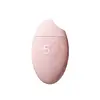What's inside
What's inside
 Key Ingredients
Key Ingredients

 Benefits
Benefits

 Concerns
Concerns

 Ingredients Side-by-side
Ingredients Side-by-side

C12-15 Alkyl Benzoate
AntimicrobialSynthetic Wax
Abrasive2-Tert-Butylcyclohexyl Ethyl Carbonate
PerfumingEthylhexyl Methoxycinnamate
UV AbsorberTriethylhexanoin
MaskingDimethicone/Vinyl Dimethicone Crosspolymer
Skin ConditioningEthylhexyl Salicylate
UV AbsorberIsononyl Isononanoate
EmollientZinc Oxide
Cosmetic ColorantDimethicone
EmollientDiethylamino Hydroxybenzoyl Hexyl Benzoate
UV FilterSilica
AbrasiveParfum
MaskingPentaerythrityl Tetra-Di-T-Butyl Hydroxyhydrocinnamate
AntioxidantTocopheryl Acetate
AntioxidantHelianthus Annuus Seed Oil
EmollientRicinus Communis Seed Oil
MaskingSodium Hyaluronate
HumectantHydrogenated Castor Oil
EmollientCentella Asiatica Extract
CleansingAscorbyl Palmitate
AntioxidantCI 77891
Cosmetic ColorantTriethoxycaprylylsilane
CI 77007
Cosmetic ColorantC12-15 Alkyl Benzoate, Synthetic Wax, 2-Tert-Butylcyclohexyl Ethyl Carbonate, Ethylhexyl Methoxycinnamate, Triethylhexanoin, Dimethicone/Vinyl Dimethicone Crosspolymer, Ethylhexyl Salicylate, Isononyl Isononanoate, Zinc Oxide, Dimethicone, Diethylamino Hydroxybenzoyl Hexyl Benzoate, Silica, Parfum, Pentaerythrityl Tetra-Di-T-Butyl Hydroxyhydrocinnamate, Tocopheryl Acetate, Helianthus Annuus Seed Oil, Ricinus Communis Seed Oil, Sodium Hyaluronate, Hydrogenated Castor Oil, Centella Asiatica Extract, Ascorbyl Palmitate, CI 77891, Triethoxycaprylylsilane, CI 77007
Water
Skin ConditioningEthylhexyl Methoxycinnamate
UV AbsorberOctocrylene
UV AbsorberButyl Methoxydibenzoylmethane
UV AbsorberBis-Ethylhexyloxyphenol Methoxyphenyl Triazine
Skin ConditioningTitanium Dioxide
Cosmetic ColorantZinc Oxide
Cosmetic ColorantBifida Ferment Lysate
Skin ConditioningNiacinamide
SmoothingPentylene Glycol
Skin ConditioningGlycerin
HumectantPhenoxyethanol
PreservativeEthylhexylglycerin
Skin ConditioningButylene Glycol
HumectantCentella Asiatica Leaf Extract
Skin ConditioningPolygonum Cuspidatum Root Extract
AntioxidantScutellaria Baicalensis Root Extract
AstringentCamellia Sinensis Leaf Extract
AntimicrobialGlycyrrhiza Glabra Root Extract
BleachingChamomilla Recutita Flower Extract
MaskingRosmarinus Officinalis Leaf Extract
AntimicrobialSodium Polyacrylate
AbsorbentCaprylic/Capric Triglyceride
MaskingParaffinum Liquidum
EmollientTri-PPG-3 Myristyl Ether Citrate
Skin ConditioningSorbitan Laurate
EmulsifyingTrideceth-6
EmulsifyingMagnolia Kobus Bark Extract
Skin ConditioningCaprylic/Capric/Succinic Triglyceride
EmollientWater, Ethylhexyl Methoxycinnamate, Octocrylene, Butyl Methoxydibenzoylmethane, Bis-Ethylhexyloxyphenol Methoxyphenyl Triazine, Titanium Dioxide, Zinc Oxide, Bifida Ferment Lysate, Niacinamide, Pentylene Glycol, Glycerin, Phenoxyethanol, Ethylhexylglycerin, Butylene Glycol, Centella Asiatica Leaf Extract, Polygonum Cuspidatum Root Extract, Scutellaria Baicalensis Root Extract, Camellia Sinensis Leaf Extract, Glycyrrhiza Glabra Root Extract, Chamomilla Recutita Flower Extract, Rosmarinus Officinalis Leaf Extract, Sodium Polyacrylate, Caprylic/Capric Triglyceride, Paraffinum Liquidum, Tri-PPG-3 Myristyl Ether Citrate, Sorbitan Laurate, Trideceth-6, Magnolia Kobus Bark Extract, Caprylic/Capric/Succinic Triglyceride
 Reviews
Reviews

Ingredients Explained
These ingredients are found in both products.
Ingredients higher up in an ingredient list are typically present in a larger amount.
Ethylhexyl Methoxycinnamate is an organic compound that provides UVB protection. It often goes by the more common name of octinoxate. It is created from methoxycinnamic acid and 2-ethylhexanol.
Ethylhexyl Methoxycinnamate absorbs UVB rays with wavelengths between 280-320 nm. UV absorbers protect your skin by using chemical reactions to convert UV rays into heat and energy.
UVB (290-320 nm) rays emit more energy than UVA rays. They are capable of damaging DNA, causing sunburns and are thought to be linked to skin cancer.
The state of Hawaii has banned sunscreens containing octinoxate due to its potential impact on coral reefs. More research is needed to bridge gaps in this research. The European Union allows higher levels of octinoxate in sunscreens than the US and Australia.
Ethylhexyl Methoxycinnamate is oil soluble. It is not stable and may lose efficacy when exposed to sunlight.
Learn more about Ethylhexyl MethoxycinnamateZinc Oxide is a mineral broad-spectrum UV filter; it is the broadest UVA and UVB reflector approved by the FDA. It also has skin protectant and skin soothing properties.
Zinc oxide is one of the most effective broad-spectrum UV filters. It protects against UVB, UVAII, and UVAI. In comparison to its counterpart titanium dioxide, zinc oxide provides uniform and extended UVA protection.
Another great benefit? This ingredient is highly photostable so it won't degrade easily under sunlight.
A common myth is that mineral UV filters are widely believed to primarily reflect UV light.
However, modern research shows titanium dioxide absorbs UV radiation like chemical filters (~95% absorption & 5% reflection).
Zinc oxide has great skin soothing properties so you'll likely find this in sunscreens formulated for sensitive skin or babies/children. It is unlikely to cause "eye sting" like other sunscreen ingredients.
Regulatory agencies consider zinc oxide to be non-toxic and safe. It has also been shown to not penetrate the skin.
Unfortunately, this ingredient does leave a visible white cast. This is why mineral sunscreens are often less cosmetically elegant than chemical or hybrid ones.
In cosmetics, zinc oxide can be found in both non-nano and nano-sized forms. The nano version is used to reduce white cast and improve the texture of sunscreen formulas.
There are ongoing concerns surrounding nano-zinc oxide's impact on marine ecosystems and whether it can be absorbed into skin.
Regarding marine ecosystems and coral reefs, there is no conclusive evidence that any form of zinc oxide (or any other sunscreen ingredients) will cause harm. The science is still developing but many consumers are keeping a close eye on this issue.
Please note, many destinations have reef-safety sunscreen rules. For instance, the U.S. Virgin Islands advises all visitors to use non-nano mineral sunscreens.
There has also been some stir about whether micronized or nano zinc oxide has potential photoxicity and absorption through the skin/lungs.
An in-vitro (done in a test tube or petri dish) study demonstrated micronized zinc oxide to have potential phototoxicity. There's no need to fret; the EU Commission's Scientific Committee on Consumer Safety has stated, "The relevance of these findings needs to be clarified by appropriate investigations in vivo." Or in other words, further studies done on living organisms are needed to prove this.
Current research shows zinc oxide nanoparticles do not penetrate intact or sunburned skin. They either remain on the surface or in the outermost layer of dead skin (stratum corneum).
Zinc oxide is one of only two classified mineral UV filters with titanium dioxide being the other one.
Fun fact: Zinc has been used throughout history as an ingredient in paint and medicine. An Indian text from 500BC is believed to list zinc oxide as a salve for open wound. The Ancient Greek physician Dioscorides has also mentioned the use of zinc as an ointment in 1AD.
Learn more about Zinc Oxide